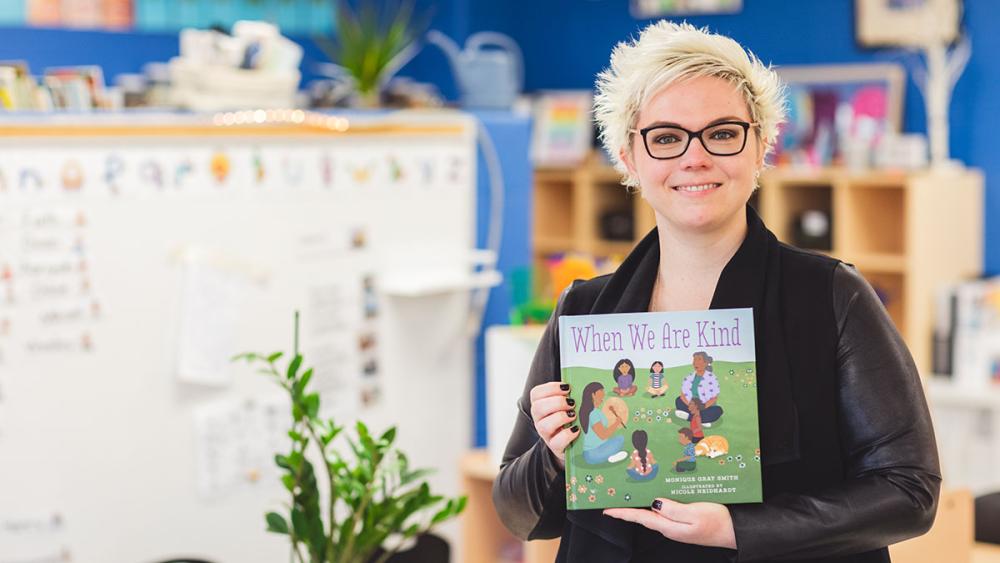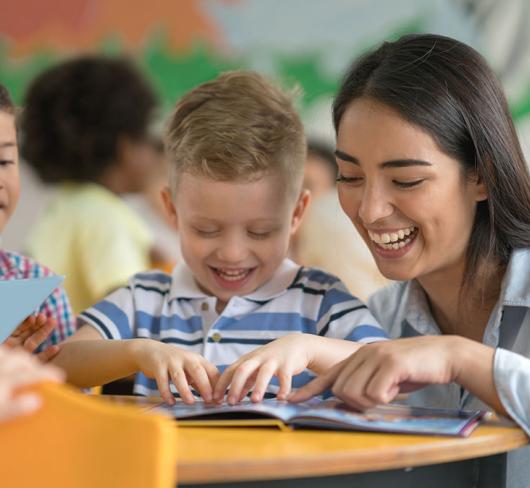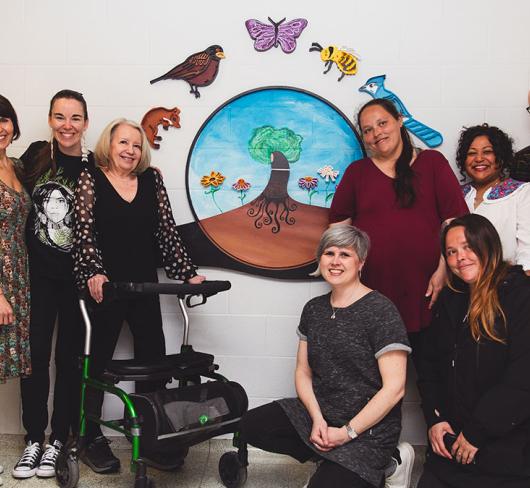
Teaching and Learning About Truth and Reconciliation with Our Youngest Learners
My journey into exploring teaching and learning about truth and reconciliation in the early years began during a board-level professional learning session that was focused on Indigenous equity. We were asked to reflect on how we could apply what we were learning about in the session to our classroom practice. One participant commented that in the early years, this should consist of reading picture books, because that was “developmentally appropriate” for students. I was inspired in that moment to learn more, reflect deeply and really explore what this work could look like in an early years setting. What are the possibilities for learning? I was eager to address the misconception that this learning is not appropriate for students in the early years and that they are too young, when in reality, this is when the work must begin.
At the time this occurred, I was teaching Kindergarten and searching for resources and information to support teaching and learning about truth and reconciliation.
What I soon discovered is that many of the resources that I came across were not specifically focused on the early years – they lumped the early years into a K-8 or K-12 category. I began having conversations with other early years educators about what this could look like with students in the classroom, with a focus on taking action.
I had also just returned to school to begin my doctoral degree in curriculum and pedagogy at the Ontario Institute for Studies in Education (OISE) at the University of Toronto and used this opportunity to search for resources or research to guide my teaching in the classroom. When I could not find anything that specifically focused on teaching and learning about truth and reconciliation in the early years, I knew I had to shift my plan for my research.
I always knew that I wanted my research to be meaningful to educators and actionable within the classroom setting, and this new focus provided the opportunity. I set out to explore how educators can respond to the Calls to Action from the Truth and Reconciliation Commission of Canada (TRC) and engage in learning related to truth and reconciliation with kindergarten students, specifically questioning what practices could support their development of knowledge, skills, and understanding about truth and reconciliation. As I was completing my course work and beginning my dissertation research, I was also applying my new learning to my practice as a kindergarten teacher and exploring how I could respond to the TRC Calls to Action with my students.
Getting Started: Interrogating My Current Practice
I began by reflecting on my current practice. I asked myself what I was doing to engage in teaching and learning about truth and reconciliation in the kindergarten classroom. How was I building knowledge, skills and understanding with the students that I taught? What learning and unlearning did I need to do in order to be able to actualize this work within the classroom context? What approach could I take to engage with this work, and how would I communicate it to others? These reflective questions provided an opportunity to think through how I was approaching reconciliation and how I could ultimately respond to the question – what could this look like in a kindergarten classroom?
Rethinking Practices and Developing an Approach to Teaching Learning
Orange Shirt Day is recognized as a day of significance in our school board on September 30. Although I knew that these days of significance would be part of the learning we would be engaging with, I was aware that teaching and learning about truth and reconciliation must move beyond this one day and be embedded throughout the school year. Since Orange Shirt Day occurs early in the school year, it provided an opportunity to begin digging deep, specifically engaging in learning with kindergarten students about the residential school system. While our learning started with Orange Shirt Day, we continued to build and layer onto this learning throughout the school year.
One of the largest shifts in my practice focused on engaging in place-based education and continuing to nurture students’ relationship with the land. A report by the Truth and Reconciliation Commission states that “if human beings resolve problems between themselves but continue to destroy the natural world, then reconciliation remains incomplete.” By rethinking where learning takes place and focusing the learning on the land, I attempted to shift my practice. We spent extended periods of time daily learning with and from the land and developing an understanding of place in the community in which students lived. This led to learning and conversations about treaties, how to protect and care for the land, as well as access to clean drinking water and water rights.
Slowing Down and Noticing Opportunities for Learning
The more I focused on teaching and learning about truth and reconciliation, the more opportunities I saw for integrating this learning into authentic teachable moments that occurred in the classroom. We had been learning about treaties as well as the land acknowledgment and the meaning of the words that we said daily, and how these connected to other learning related to truth and reconciliation. One day, while walking by the front of the school, a student stopped and noticed the school sign at the end of the driveway that included the name of the school, address, and board logo. She asked how people who were visiting the school would know the treaty land the school was located on if they were not present for the announcements and visiting for the first time. I paused for a moment to reflect on how my response as an educator could impact the potential for learning in this moment. I could have answered her question, but I decided that this moment could act as a spark, a natural opportunity for further inquiry.
I asked the students what their thoughts were in that moment. A passionate discussion ensued, and students decided that they wanted to act and advocate to change the school sign so it acknowledged the traditional territory the school is on. They felt it was important that anyone visiting the school or in the community was aware of the treaty land they were on. When we returned to the classroom, we talked about how to turn their plans into a reality. They brainstormed who they could discuss their plans with, and we engaged in discussion and learning about who had the power to change the sign. Students decided they wanted to write a letter to the school administrators and the school board to advocate for the change. During this process, we talked about what they thought should be included on the sign so everyone could understand their role as a treaty partner. Students were also eager to investigate what materials would be suitable to use for the sign so it would withstand the natural elements. This provided an opportunity for ample problem-solving and innovating to occur. It was exciting to see them take some of the explicit learning we had been doing related to treaties and land acknowledgments and apply it in a meaningful way. I was really amazed by how some of the implicit learning we were doing around power, privilege, and coloniality was being demonstrated through this authentic opportunity to make change. It really illustrated for me the importance of slowing down and taking advantage of teachable moments that occur in the daily interactions of a classroom.
Building Knowledge, Skills, and Understanding with Early Learners
There were various practices that I focused on in the classroom to build the knowledge, skills, and understanding students needed to engage in teaching and learning about truth and reconciliation. Three examples of these practices included using picture books to support instruction, co-constructing an understanding of the vocabulary necessary to engage in this work, and encouraging students to act.
Picture books written by Indigenous authors help make information about truth and reconciliation accessible to early learners. These texts allowed me to scaffold students’ understanding and provided opportunities to begin discussions about various topics. What was helpful was being able to re-read a text multiple times throughout the year and discuss how students’ understanding had developed over time. Students enjoyed reading these books together as well, returning to them time and again as staples in our classroom library.
I also focused on co-constructing an understanding of the vocabulary and terms that students would need to engage in this learning. By engaging in conversations and instruction about the meaning of terms, students were able to better articulate their thinking and understanding in a way that was meaningful for them. Some terms that I focused on developing an understanding of included Elder, fairness, Indigenous, injustice, reconciliation, and treaty. For support in building the necessary vocabulary with students, check out the First Nations Child and Family Caring Society’s online resource Spirit Bear’s Virtual School Glossary – A Living Document for definitions of various terms you can use as a starting point in building this understanding with students (fncaringsociety.com/publications/spirit-bears-virtual-school-glossary).
As time passed, I began to notice that students were interested in making a difference and sharing their understanding with others. Students demonstrated their advocacy skills in various ways, both within the school environment and within the community. One example of how students took action related to advocating for equal rights and funding for First Nations children related to learning about the First Nations Child and Family Caring Society’s “Have a Heart Day” campaign. Students wrote and mailed letters sharing their learning about funding inequities to elected officials. Additionally, they wanted to share their learning with others by making a video. Students brainstormed what they would include in their video, created a background that included some of the picture books they had been reading and wrote a script. We filmed the video and shared it with the community on social media, amplifying the learning far beyond the four walls of the classroom and calling others to action as well. It was amazing to see the community and school response.
Tying It All Together
There are powerful possibilities for developing a strong foundation for knowledge, skills, and understanding about truth and reconciliation with students in Kindergarten and the early years. Justice Murray Sinclair, chair of the Truth and Reconciliation Commission, points to education as the key to reconciliation, stating, “Education got us into this mess and education will get us out of it.” Teaching and learning about truth and reconciliation must begin with our earliest learners – in Kindergarten. They are not too young to engage in learning and make a difference by taking action towards change.
What has been most impactful to me as an educator-researcher has been applying my learning in the classroom with students and co-learning beside them. We have been able to learn about treaties, residential schools, engage in land-based education with traditional teachings, and participate in campaigns by the First Nations Child and Family Caring Society such as Have a Heart Day (in addition to days of significance such as Orange Shirt Day and Indigenous History Month). Teaching and learning about truth and reconciliation is a core part of our classroom community and my practice as an educator. It has also been amazing to be in conversation and community with other early years educators, demonstrating that this work is possible in contexts across the province. Although we might turn to picture books as one way to support this work, there are so many other ways that kindergarten students, who are “competent, capable of complex thinking, curious and rich in potential and experience,” as described in the Ontario Kindergarten Program document (2016), can engage in this work. What will your next step be in teaching and learning about truth and reconciliation with your students?
Michelle McKay is a member of the Peel Elementary Teachers’ Local.
10 Questions to Ask Yourself About Teaching and Learning About Truth and Reconciliation in the Early Years
- What next step will I take in my practice?
- How do my identity (social location and positionality), prior knowledge and lived experiences impact how I approach this work?
- How will teaching and learning about truth and reconciliation be responsive to the students and community in which I teach?
- What resources am I currently using to support this teaching? Who are the author(s) – whose voice is centred or missing? What new resources can support me in doing this work in my practice?
- How can I engage in learning about truth and reconciliation throughout the school year, beyond days of significance (e.g., Orange Shirt Day)?
- How can I building authentic relationships with local Indigenous Peoples and engage in this work in community?
- How can I support students to take action towards positive change?
- How can I continue to engage in learning (and unlearning), both professionally and personally, related to truth and reconciliation?
- How can I call others to action and support them in teaching and learning about truth and reconciliation with the students they teach?
- How do I anticipate overcoming or addressing obstacles or challenges that I may encounter in doing this work?
Resources to Support Teaching and Learning About Truth and Reconciliation in the Early Years
- ETFO First Nations, Métis & Inuit Education Resources (etfofnmi.ca)
- Spirit Bear Virtual School by First Nations Child & Family Caring Society (fncaringsociety.com/spirit-bear/spirit-bear-virtual-school)
- Walking Forward: Learning from Place by Heidi Wood and Gillian Judson (educationthatinspires.ca/files/2022/05/Walking-Forward-Wood-Judson-2022.pdf)
- Wayi Wah! Indigenous Pedagogies: An Act for Reconciliation and Anti-Racist Education by Jo Chrona (Portage & Main press) (portageandmainpress.com/Books/W/Wayi-Wah!-Indigenous-Pedagogies)
- Natural Curiosity: The Importance of Indigenous Perspectives in Children’s Environmental Inquiry (naturalcuriosity.ca)

